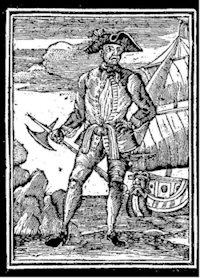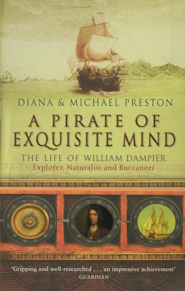The full title of this act:
An Act for making perpetual so much of an Act made in the Tenth Year of the Reign of Queen Anne, for the reviving and continuing several Acts therein mentioned, as relates to the building and repairing County Gaols; and also an Act of the Eleventh and Twelfth Years of the Reign of King William the Third, for the more effectual Suppression of Piracy; and for making more effectual the Act of the Thirteenth Year of the Reign of King Charles the Second, intituled, “An Act for establishing Articles and Orders for the regulating and better Government of His Majesty’s Ships of War, and Forces by Sea.”
This act commenced on 23rd November 1719. Section 3 amends the Piracy Act 1698, which was about to expire, making it perpetual, as well as extending existing Vagrancy acts. It was repealed on 15th July 1867 by the Statute Law Revision Act.…

 The Piracy Act 1717 was an Act of the Parliament of Great Britain. Its long title was “An Act for the further preventing Robbery, Burglary, and other Felonies, and for the more effectual Transportation of Felons, and unlawful Exporters of Wool; and for declaring the Law upon some Points relating to Pirates.”
The Piracy Act 1717 was an Act of the Parliament of Great Britain. Its long title was “An Act for the further preventing Robbery, Burglary, and other Felonies, and for the more effectual Transportation of Felons, and unlawful Exporters of Wool; and for declaring the Law upon some Points relating to Pirates.” Although not the most well-known pirate captain, Edward England was considered important enough to receive his own chapter in Charles Johnson’s
Although not the most well-known pirate captain, Edward England was considered important enough to receive his own chapter in Charles Johnson’s  William Dampier was an English adventurer and pirate who preyed on ships on the Spanish Main. Poor and ill-educated and determined to make his fortune, he nonetheless had a passion for exploration and scientific research. Not only a pirate, he was the first to map the winds and currents of the world’s oceans; lead the first recorded party of Englishmen to set foot on Australia – 80 years before Cook; write about Galapagos wildlife 150 years before Darwin, who drew on Dampier’s notes in his own work; was the first travel writer: His book, A NEW VOYAGE AROUND THE WORLD, was an instant bestseller when it was published in 1697 and is said to have influenced the novels of Swift and Defoe. A man full of contradictions: he who achieved so much ‘blew it’ later in life, declining into scandal, failure and even farce.…
William Dampier was an English adventurer and pirate who preyed on ships on the Spanish Main. Poor and ill-educated and determined to make his fortune, he nonetheless had a passion for exploration and scientific research. Not only a pirate, he was the first to map the winds and currents of the world’s oceans; lead the first recorded party of Englishmen to set foot on Australia – 80 years before Cook; write about Galapagos wildlife 150 years before Darwin, who drew on Dampier’s notes in his own work; was the first travel writer: His book, A NEW VOYAGE AROUND THE WORLD, was an instant bestseller when it was published in 1697 and is said to have influenced the novels of Swift and Defoe. A man full of contradictions: he who achieved so much ‘blew it’ later in life, declining into scandal, failure and even farce.…